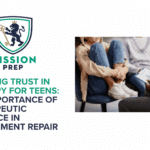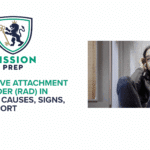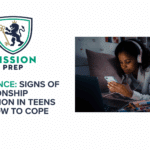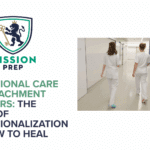DSED in Teens: What Is Disinhibited Social Engagement Disorder?

It’s not unusual for teenagers to be outgoing. However, if a teen is overly friendly with strangers or doesn’t seem to understand personal boundaries, they may have more than just a social personality.
DSED in teens, or disinhibited social engagement disorder, is an attachment disorder that can arise from early childhood. Teens with DSED may have overly friendly teen behaviors, such as hugging strangers, trusting people they’ve only just met, or sharing personal details far too quickly. These actions might seem harmless, but they can actually be a sign of deeper issues related to childhood trauma and attachment.
Professional support is essential for helping your teen to heal from DSED. Understanding what it is and why it develops can help teens build healthier, safer relationships. On this page, we’ll explore:
- What DSED is
- Teen attachment disorder symptoms
- What causes DSED in teens
- Challenges faced with DSED
- Diagnosis and treatment options for teen DSED
- Finding professional support for teens with DSED
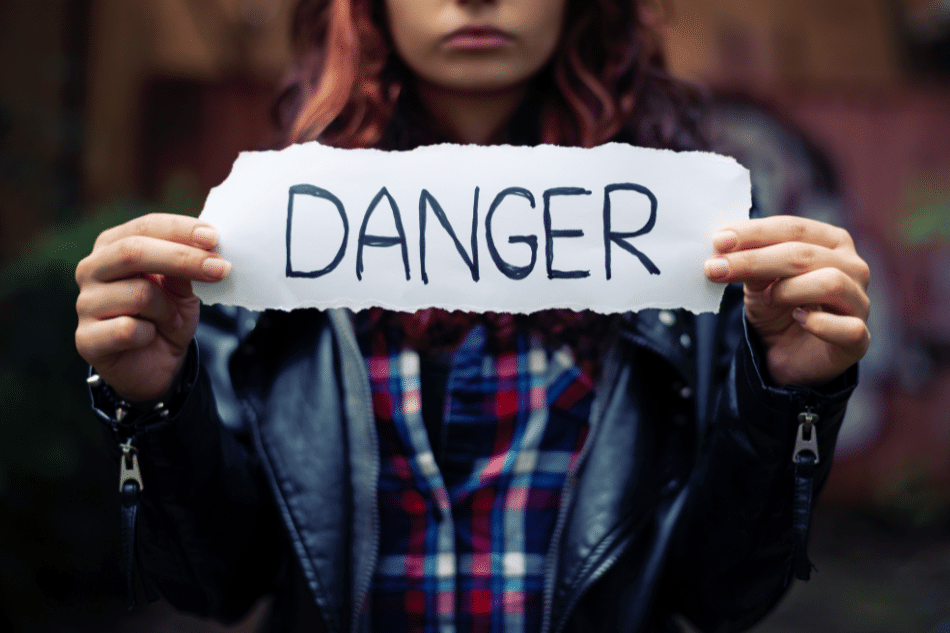
What Is Disinhibited Social Engagement Disorder?
Disinhibited social engagement disorder (DSED) is a type of attachment disorder. It can develop very early in childhood, and its effects can be felt all the way through to adulthood. The following sections take a look at how DSED can play out from childhood to adolescence.
DSED in Children
Usually, children show some degree of wariness or uncertainty around strangers, looking to their parents or caregivers for reassurance or safety. However, children with DSED usually aren’t scared when meeting someone for the very first time. They can be overly friendly with people, including hugging random strangers on the street.1 In other words, they don’t show the usual behavior you would expect when a child meets an unfamiliar adult.DSED in Teens
The disinhibited social behavior youth and teenagers experience can look like a lack of social boundaries. They may talk with strangers or be happy to walk away with them. You may think of these actions as just being your teenager’s “quirks” or that they are just a naturally friendly and trusting person. But a lack of healthy boundaries with strangers can actually be a sign of a deeper attachment issue. For instance, your teen may be very trusting of others, but this can pose a safety issue: they have no sense of “stranger danger.”
The following information takes a brief look at attachment disorders before going deeper into the causes, signs, and treatment for DSED.
DSED vs RAD in Teens
Two attachment disorders can develop in children if healthy attachments are disrupted during their early years. These are DSED and reactive attachment disorder (RAD). In many ways, DSED and RAD could be seen as two sides of the same coin. Both conditions can be caused by trauma, neglect, and early attachment problems, but each disorder looks very different.
In DSED, children and teens can be overfamiliar with people, trusting strangers as much as they trust their own parents or caregivers. They may be overly chatty or friendly, and may even walk off with unknown adults without thinking about danger. In other words, they might seek comfort from anyone.
With RAD, however, children are often unlikely to look to others for comfort when they feel distressed, even their parents or caregivers. They find it difficult to have emotional attachments to people, and can seem withdrawn or avoid others.3,4 You can find out more about RAD on our page, Reactive Attachment Disorder in Teens.
When working with attachment disorders, early intervention is the key to effective treatment. Professional support allows teens to learn how to manage their emotions and create healthy relationships with others.
Key Signs of DSED in Adolescents
Recognizing the symptoms of DSED in your teen means you can find professional support to help them. The main symptoms of disinhibited social engagement disorder to watch for in teenagers include:3,5,6
Acting in an overly familiar way with unfamiliar adults- Having problems with peers, parents, teachers, and coaches
- Only engaging in superficial relationships
- Disliking conflict
- Trouble distinguishing who’s trustworthy from who’s not
- Having no wariness when approaching strangers
- Craving kindness and physical contact
- Willingness to go away with an unfamiliar adult with very little or no hesitation
- Lacking social boundaries with people
- Asking strangers very personal questions
- Acting impulsively
- Attention-seeking behaviors
- Having little inhibition around strangers (treating them as though they’ve known them for a long time)
As a parent, you may also remember other symptoms from when your child was younger. For instance, if they fell and scraped their knee, maybe they didn’t check in with caregivers for reassurance. Perhaps they looked to someone else for comfort, including strangers. Or maybe they never seemed scared or shy when meeting new people.
If you can see a couple of these signs in your teen, they may be struggling with an attachment disorder such as DSED. With the right help and support, they can go on to have healthier, safer relationships with people.
What Causes DSED?
The exact cause of DSED is unknown, but there are risk factors that can disrupt a child’s early emotional attachments.
Risks or Causes of DSED in Youth:2,6,7
- Physical, emotional, or sexual abuse
- Neglect
- Danger at home
- A parent being absent or unavailable for emotional support
- Food insecurity
- A traumatic event, such as the death of a parent
- Multiple caregivers
- Violence
- Time spent in institutional care, such as orphanages
- Spending time in many foster care placements
These connections create a template for future relationships, how we manage our emotions, and how we see the world. When attachments are not secure, children may grow up with a skewed blueprint of how they should act, who they can trust, and what their place in the world is. You can find more in-depth information about the importance of the parent-child bond on our page Understanding Attachment Styles in Teenagers.
Getting professional support for an attachment disorder can help your teen develop a healthier attitude toward others and themselves. Before we discuss treatment options, let’s look at the impact DSED can have on a teen’s life.
Challenges That Teens With DSED Face
Personal Life
On a personal level, emotional regulation for DSED can be tricky for teens. They may struggle to manage their emotions or act impulsively, especially if their early childhood was marred by neglect or trauma. Research shows that self-esteem and self-worth can also suffer; teens with DSED may struggle more than peers when it comes to mental and physical health, as well as risk-taking behaviors.2,8School
When it comes to school, adolescents with DSED may have problems with their peers, teachers, and coaches. Often, teens with DSED may not respect the boundaries put in place by teachers or other adults, which can lead to conflict. They may struggle with their academic work, feel unable to focus, be distracted easily, and struggle with sticking to boundaries. Each of these issues can impact their ability to learn.2 Because they lack social boundaries, these teens may also experience misunderstandings with their classmates and potential social isolation.
Relationships
In terms of relationships, teens with DSED tend to develop superficial relationships with others. This may come down to how initiating and maintaining deeper relationships can be more difficult in the absence of early healthy attachments.2 As a result, teens with DSED could miss out on important, deep, and meaningful connections with others.
Safety and Boundaries
Youth trust and boundaries can be an issue for teenagers with DSED, as the disorder means they tend to trust everyone, even people that they probably shouldn’t. This raises the risk of harm from potential mistreatment by others due to their trusting nature. Equally, because they sense no threat from strangers, they could walk into dangerous situations without realizing it.
Diagnosis and Treatment for DSED Adolescents
You may be wondering how DSED is diagnosed, and what can be done to help your teen. We will cover these topics in the next few sections.
Teen DSED Diagnosis
If you’ve been reading this article and see your teen reflected in some of the symptoms, you may be wondering Does my teen have DSED? If this is the case for you, you may want to seek professional advice. One option is discussing your concerns with your child’s pediatrician or school counselor.
However, a comprehensive psychiatric assessment by a qualified mental health professional can provide the confirmation you’re looking for. The assessment usually involves a doctor or mental health professional asking you and your teen questions about their emotional development, mental state, and history.
Answers to these questions, along with seeing how your teen functions in the professional environment, can provide information toward a diagnosis. If your teen is diagnosed with DSED, a treatment plan will be created to help them heal and support them to form better relationships with others.7
Managing DSED in Teenagers
If your teen has been diagnosed with DSED, please know that, although there is no cure for DSED, treatment is available to effectively manage symptoms.Psychotherapy is the most common treatment, and can involve both the teen and their parents or caregivers. The focus of therapy is to understand the relationship between the teen and their caregivers, and to strengthen that relationship.1 Therapy may also involve social skills training for the teen to help them understand and navigate boundaries.2
Improvements can take time, so remember to be patient. There is no quick fix when it comes to healing. But with the right help and support, recovery is possible.

Mission Prep: Professional Support for Teens with DSED
Mission Prep is a judgment-free zone that understands how disruptions to attachment bonds can and do happen – often despite the best intentions.
Given the right support, teens with DSED can learn how to have and respect boundaries, build healthier relationships, and grow both emotionally and socially. Early intervention is the key to healing.
If you are concerned your teen may have DSED, know that you’re not alone and that professional help is available. At Mission Prep, our team of mental health experts specializes in treating teens with attachment disorders and can guide you every step of the way.
Call or contact our team today through our secure online webform to discover how we can help your teen heal and create positive, lasting change.
References
- American Academy of Child & Adolescent Psychiatry (AACAP). (2017). Attachment disorders. https://www.aacap.org/AACAP/Families_and_Youth/Facts_for_Families/FFF-Guide/Attachment-Disorders-085.aspx
- Sissons, B. (2024, April 16). What to know about disinhibited social engagement disorder. Medical News Today. https://www.medicalnewstoday.com/articles/disinhibited-social-engagement-disorder
- WebMD. (2023, May 20). What is Disinhibited Social Engagement Disorder? https://www.webmd.com/children/what-is-disinhibited-social-engagement-disorder
- Marie, S. (2021, September 29). Symptoms of Disinhibited Social Engagement Disorder (DSED). Psych Central. https://psychcentral.com/disorders/symptoms-of-disinhibited-social-engagement-disorder
- Morrin, A. (2025, May 19). Disinhibited Social Engagement Disorder: What every parent needs to know. Verywell Mind. https://www.verywellmind.com/what-is-disinhibited-social-engagement-disorder-4138254
- Reid, S. (2023, June 7). Disinhibited Social Engagement Disorder (DSED) HelpGuide.org. https://www.helpguide.org/family/parenting/disinhibited-social-engagement-disorder-dsed
- Whelan, C. (2017, April 24). Disinhibited Social Engagement Disorder (DSED): symptoms, treatment, and more. Healthline. https://www.healthline.com/health/disinhibited-social-engagement-disorder
- Seim, A. R., Jozefiak, T., Wichstrøm, L., Lydersen, S., & Kayed, N. S. (2021). Self-esteem in adolescents with reactive attachment disorder or disinhibited social engagement disorder. Child Abuse & Neglect, 118, 105141. https://doi.org/10.1016/j.chiabu.2021.105141

